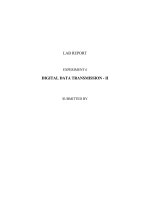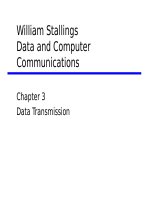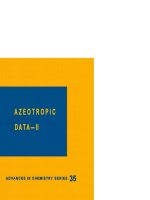DIGITAL DATA TRANSMISSION - II
Bạn đang xem bản rút gọn của tài liệu. Xem và tải ngay bản đầy đủ của tài liệu tại đây (248.45 KB, 20 trang )
LAB REPORT
EXPERIMENT 6
DIGITAL DATA TRANSMISSION - II
SUBMITTED BY
PURPOSE
The Objectives of this laboratory are:
1. To examine the frequency spectrum of an FSK signal.
2. To examine the correlation between two FSK signals.
3. To implement and investigate a coherent FSK detection system.
EQUIPMENT LIST
1. PC wth Matlab and simulink
LABORATORY PROCEDURE
I. Spectrum of an FSK Signal :
FSK involves frequency shifting a carrier between known fixed frequencies to
convey digital data.
Normally, FSK modulation is achieved using just two frequencies to represent
binary data. For example, a frequency of 2000 Hz may represent a binary 1
(mark) and 1000 Hz a binary 0 (space). The energy of the signal alternates
between the mark and space frequencies to convey the digital message.
FSK describes the modulation of a carrier (or two carriers) by using a different
frequency for a 1 or 0. The resultant modulated signal may be regarded as the sum
of two amplitude modulated signals of different carrier frequencies:
Figure 1a: Frequency shift keying
Figure 1b: Frequency shift keying -- frequency domain
A. The circuit was set up according to figure 6A shown below. It is a basic
assembly to generate a FSK signal.
Figure 6a Spectrum of a FSK signal – FSK generation
Figure 6bInput signal for generating FSK signal
The output of the FSK generator is shown below.
The FSK Modulator module consists of f
0
and f
1
connectors, which are frequency
adjustable signals of the form;
s
x
(t) = A cos2Πf
x
t
where x = 0 or 1 and the module is in FREE – RUNNING. However, when the switch is
in the SYNC position , a time restriction is placed on the waveforms:
s
x
(t) = A cos2Πf
x
t for 0 < t < T
where T = bit rate = 1/f
s
(selected by the Master Clock).
In this mode, a cosine begins at the start of every data period and proceeds at the
frequency fx until the end of the data period. Then the process repeats.
Figure 6c The FSk Modulated signal
B. Cross – Correlation of the Two FSK Signals.
A. FREQUENCY SHIFT KEYING - ERROR PROBABILITY:
The Probability of error of an FSK system depends on the separation of “distance” d,
between two (or more) signals as given by the equation below:
P.E = ½ erfc(√(E
b
/ N)d).
Thus the probability of error is minimum when the distance of separation is maximum i.e
larger the d, smaller is the P.E.
The distance d is given by:
d = (1 - ρ) / 2
where
ρ = (1 / E)
0
∫
T
s
0
(t) s
1
(t) dt.
The integral is the cross-correlation function over the period 0 to T. ρ is restricted to
values between +1 and –1.
Figure B (a) The FSk Modulated signal
Figure B (b) The FSk signal
Figure B (c) Block parameters of the Digital Signal source
Figure B (d) The FSk signal – Block parameters of sample and hold
Figure B (e) The block parameters of Pulse generator
Figure B (f) The FSk multiplied modulated signal
The DC meter is implemented using a Display block
MINIMUM SHIFT KEYING:
Minimum shift keying occurs when ρ = 0 or , or (ω
1
- ω
0
) T = Π or the frequency
between a ‘1’ and a ‘0’ = 1 / 2T.
i.e (
f
1
- f
0
) = 1 / 2T.
Most negative ρ occurs when (ω
1
- ω
0
) T = 3Π / 2 or (
f
1
- f
0
) = 3 / 4 T.
B. Figure 6B was implemented for this part of the lab.
The various values for f
1
,f
0
and f
s
were as follows:
f
s
= 1khz = 1 / T
f
0
= 5.0 khz.
f
1
(in khz)
Vd.c (in Volts)
ρ
f
1
- f
0
(
f
1
- f
0
) T
5.0 + 3.3075 + 1.0 0 0
5.25 + 2.613 + 0.79 0.25 0.25 e
-03
5.5 + 0.3518 + 0.1063 0.5 0.5 e
-03
5.75 - 0.803 - 0.2427 0.75 0.75 e
-03
6.0 - 0.29 - 0.0876 1.0 1.0 e
-03
6.25 + 0.402 + 0.1215 1.25 1.25 e
-03
6.5 + 0.149 + 0.045 1.5 1.5 e
-03
6.75 - 0.353 - 0.1067 1.75 1.75 e
-03









